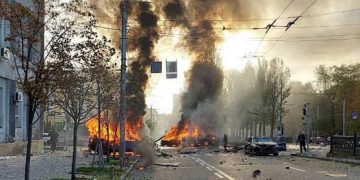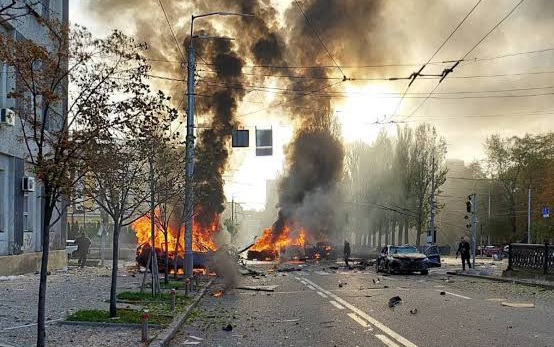By Oyintari Ben
On Monday, explosions rocked the Ukrainian cities of Lviv, Ternopil, and Dnipro after Russia charged Ukraine with planning a massive blast that destroyed a vital bridge connecting Russia and Crimea.
Emergency services were cited by the Ukrainian national channel Suspilne reporting fatalities and injuries in Kyiv, but no other information regarding casualties was provided.
The Kyiv Mayor, Vitali Klitschko, said on the messaging app Telegram that there had been “several explosions in the Shevchenskivskyi neighbourhood — in the centre of the capital.”
According to witnesses, one of the city’s intersections had a massive crater, and automobiles adjacent were entirely destroyed, charred, and scarred with shrapnel.
The western Ukrainian cities of Lviv, Ternopil, and Zhytomyr, as well as the central Ukrainian city of Dnipro, all reported explosions.
Kyiv was most recently attacked in June. But in contrast to other assaults, which mainly affected Kyiv’s periphery, Monday’s strike targeted several spots in the middle of the city.
In the face of fierce resistance supported by western weapons, Russia abandoned an early push on Kyiv. Since then, Moscow and its allies have concentrated on the south and the Donbas, an area in eastern Ukraine comprised of the cities of Luhansk and Donetsk, using heavy artillery in some of the bloodiest land battles in Europe since the Second World War.
Fighting has recently been concentrated in the districts to the north of Crimea, particularly Zaporizhzhia, from which six missiles were fired overnight on Saturday from Russian-occupied territory.
Vladimir Putin, the President of Russia, declared on Sunday that the explosion that occurred on the Kerch Strait bridge the day before—a crucial supply route for Moscow’s soldiers in southern Ukraine—was “an act of terrorism intended to damage critically essential civilian infrastructure.”




































